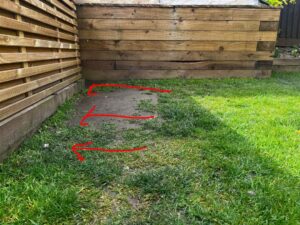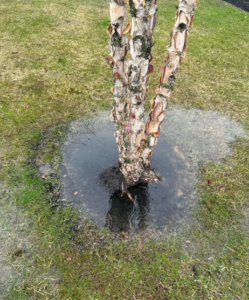VIEWERS QUESTION: Can you help me with this. My lawn runs away to the left hand side of the garden (see pic). When it rains it doesn’t flood but it does get boggy and seeps into the wooden unit on the side. What’s the best approach to stop this from happening?

THE ANSWER
First thing first, grade around your house, or at least where the ground is slopped towards (or at) your house. You want a 1″ drop for every 1′ you move away from your foundation for the first 5–10 feet. Though this is not always possible, it’s best to get as close as you can. In other words, create a small slope, starting at your highest point against your house, and then create a downhill effect as you move away (your drop). It should mimic a hill. This will allow water to run away from the foundation. It is important to ensure that at least four inches of your foundation (whether it is concrete, block, or stone) is visible above the soil level, and that no dirt comes in contact with the siding or wood material. If you are going to tackle this yourself, I recommend using bagged soil. I’M JUST KIDDING!! This is the last type of soil you want to use due to how rich it is in organic content. Plus, you’d need a lot of bags to cover the area. Your best bet is to go with screened topsoil from a local landscape supplier or garden center. It’s sourced locally and is probably a native silty clay loam, which is easy to work with, settles nicely, and is great for growing plants.
IF THAT DOESN’T FIX THE SOGGY LAWN, THIS WILL

If your lawn still seems to be boggy or retaining a lot of water (more than usual), you may want to consider installing a french drain system in your yard. A french drain is a trench filled with gravel or rock, or both, with or without a perforated pipe that redirects surface water and groundwater away from an area.
Now, let’s talk installation! I’ll walk you through this step-by-step making your french drain installation a success. First, you want to determine where your drain is going to run. It’s best to run it in the direction where there is a drop. Meaning, where the yard is slopped downward. Begin by cutting out the grass in squares, so you can set it aside on a tarp and not the grass. This is so you can go back later and make it look like you were never there. You then want to dig a trench 10-12″ wide and 12-16″ deep, setting the topsoil aside onto a tarp. I will say this now, the deeper you go, the more stone you can add, which is going to give you better drainage. Once you have your trench dug, you then want to line it with a geo textile fabric leaving about 8″ hanging over each side of the trench. To keep the fabric out of the way, you can set bigger rocks on it or use landscape staples to staple it to the ground for the time being. After that, you will then install 1-2″ of river rock at the bottom of the trench. I say river rock because the bigger voids move water faster and your goal is to move it as fast as possible. Smaller voids move water slower. You then want to set your perforated pipe in your trench. If you have enough slope in your yard, you can take one end of your french drain to daylight. The other end should be capped off accordingly. Once you have your pipe in the trench, you can begin to backfill it with the remaining river rock. It’s recommended to have 12″ of stone inside the trench. This goes back to digging your trench deep enough. After that, take the fabric your have folded over to the sides and give the stone a nice tight burrito wrap. You will use landscape staples to pin the burrito together, so the fabric stays in place. Your french drain is now done! Go ahead and add back a little topsoil over the fabric and put the grass back on top. Job well done!
If you or anyone else has questions, feel free to comment below or send me an email. HAVE A SPECIFIC GARDENING OR LANDSCAPE QUESTION? I would love to help answer it! Email my team your question(s) along with whatever pictures you have (the more the better) and they will forward them to me and I will gladly do a blog post on it. You will receive an official link to the answer.







1 thought on “Water coming at the house and wet soggy lawn”
Oh tay 👌🏻
Comments are closed.